Anyone, who cares for an elderly adult, will know that as the person gets older and weaker, personal hygiene becomes more of an issue. With elderly women in particular, there is a risk of urinary tract infections (UTI’s) and a bidet can be of great help.
Original Medicare will not typically cover the cost of a bidet. Bidets are classed, by Medicare, under toilet seats which are not considered “medically necessary”.
You may though get assistance with paying for a bidet from state programs such as Medicaid, HCBS programs, waivers, 1915 waivers, State Assistive Technology Programs and other state financial assistance programs for the elderly.
Contents Overview & Quicklinks
Why does Medicare Part B reject bidets for coverage ?
Does Medicare cover bathroom equipment ?
Will Medicare cover exercise equipment ?
Does Medicare cover elevators ?
Will Medicare pay for bathroom modifications ?
What medical supplies does Medicare pay for ?
What type of medical equipment does Original Medicare cover ?
How do you get coverage from Medicare Part B for Durable Medical Equipment ?
What does your loved one do once they have their signed prescription ?
Finding a local Medicare-enrolled Supplier near you
List of durable medical equipment typically covered by Medicare
Get free assistance with understanding Medicare
Programs and waivers which offer the most latitude in what they consider to be DME ?
How to find the HCBS programs, waivers and 1915 waivers with their eligibility criteria in your state ?
What is the procedure for getting DME with Medicaid state waivers and HCBS programs ?
What are bidets ?
Bidets were traditionally a bathroom fixture which you sat on to wash yourself after using the toilet.
The bidet will squirt up a stream of water onto the user’s private parts, and get everything sparkling clean.
Nowadays, bidets can be an individual fixture, or they can be added to an existing toilet, as a bidet toilet seat.
The traditional bidet is separate from the toilet, which means that you have to get up from the toilet, and move over to the bidet, and this can be problematic for elderly loved ones who have mobility issues, for all sorts of reasons.
A bidet toilet seat, though, is fixed directly to the toilet, with no transfer is required, making it much easier for your elderly loved ones to use, and to remain clean.
Why does Original Medicare Part B reject bidets for coverage ?
For any equipment to be covered by Original Medicare Part B for home use, it must first fall into the category of medical equipment called Durable Medical Equipment, or DME.
Medicare does not classify bidets as DME, because it considers that they are “not medical equipment”.
You can take a look at the guidelines on the Centers for Medicare and Medicaid Services website – CMS.gov – where you will find the “National Coverage Determination (NCD) for Durable Medical Equipment Reference List (280.1)”. You can click here to see it.
Does Medicare cover bathroom equipment ?
Medicare Part B’s coverage for equipment for use in the home extends to items which are “medically necessary”, but not to items which are for safety, and which will, hopefully, prevent accidents.
Much of the safety equipment for helping the elderly to maintain their independence in their homes, creating a safe environment for them, is not covered by Original Medicare.
The following items for bathroom safety are not covered by Original Medicare Part B –
- grab bars
- raised toilet seats
- transfer seats
- bath lifts
- floor to ceiling poles
- shower chairs
- bath chairs
- toilet safety frames
Some medical equipment, though, for the elderly with mobility issues, is covered (as long as it is “medically necessary”) and can be used in the bathroom to make it a safer place –
- crutches
- walkers
- bedside commodes
Bedside commodes, as long as they have height adjustable legs, can be used as –
- a raised toilet seat
- a shower chair if they are waterproof
- a safety frame for the toilet
Walkers which are waterproof –
- can be used as an aid to standing in the shower
- any type of walker can be used as a safety rail in front of the sink or mirror
- as an aid for sitting down on the toilet
With regard to Medicare Advantage Plans, in 2019, the Centers for Medicare & Medicaid released their plans to increase the competitiveness and coverage of Medicare Advantage and Part D.
Beginning in 2019, Medicare Advantage plans can now offer supplemental benefits that are not covered under Medicare Parts A or B, if they diagnose, compensate for physical impairments, diminish the impact of injuries or health conditions, and/or reduce avoidable emergency room utilization.
The source for this is – “CMS finalizes Medicare Advantage and Part D payment and policy updates to maximize competition and coverage” April 1, 2019. You can read the whole release on the CMS.gov website here.
It can be assumed, within reason, that some plans may be offering some bathroom equipment, or modifications, such as walk in tubs and grab bars, in 2020 and ahead.
Will Medicare cover exercise equipment
Medicare Part B does not give coverage to exercise equipment for use in the home, as it is not considered “medically necessary” by Original Medicare, and usually neither are exercise classes.
Medicare Part B will, though, cover physiotherapy and occupational therapy, where it has been prescribed as “medically necessary” by a Medicare-enrolled physician.
The therapist must be providing the treatment on an outpatient basis, must be Medicare-certified, and the therapy must be under regular review by the prescribing physician.
As with durable medical equipment, you will need to make sure that the therapists charge the Medicare-approved price for the therapies.
Medicare Part B will typically cover 80% of the Medicare-approved fee for the therapy, and the patient covers the remaining 20% of the Medicare-approved fee, plus their annual deductible if it applies.
With a Medicare Advantage Plan, you may discover that you have coverage for exercise plans and gyms, as Advantage Plans have some extra benefits depending on the plan provider, but you will need to check with them.
Does Medicare cover elevators ?
Medicare Part B does not cover elevators or stairway elevators, meaning stair lifts, as Medicare lists them as being convenience items which are not medical in nature.
In the National Coverage Determination (NCD) for Durable Medical Equipment Reference List (208.1) it says –
Elevators Deny – convenience item: not primarily medical in nature (1861 (n) of the Act).
and for also stair lifts –
Stairway Elevators Deny – (See Elevators.(1861 (n) of the Act).
If you want to check it for yourself, you can use this link to check it here, on the Center for Medicare and Medicaid Services website, CMS.gov.
But, at the end of 2020 Medicare Advantage Plans are going to be allowed to offer extra benefits tailored for certain chronic conditions, and some Advantage plans may be allowed by Medicare to offer stair lifts.
So keep a look-out for that.
Will medicare pay for bathroom modifications ?
The large majority of home modifications for elderly adults are not covered for by Medicare Part B.
Medicare Part B considers bathroom modifications not to be primarily medical in nature, but rather for comfort.
Medicare Part B covers items of durable medical equipment and supplies which it considers to be “medically necessary”.
Medicare will, in rare instances, cover the cost of a bathroom modification, and items such as walk in bathtubs, if it is proven that it is an unconditional “medical necessity” – this requires a medical diagnosis for proof of their need, and a prescription of “medical necessity” from a physician which outlines –
- why the patient cannot live without the modifications – why they are necessary
- what specifically is needed from the model required, or the type of modification
Having a prescription and diagnosis is no guarantee that you will get your equipment, or modification covered, and you will in cases where it is not policy to cover such items, or work, have to pay up front, and hope that Medicare will agree that your case is one of “medical necessity”, and reimburse you.
It is very rare that Medicare will go against its own policy.
Medicare will require that there is a reasonable expectancy that the equipment, or modification, will maintain the health or lead to an improvement in the condition of the individual that it is for.
What Medical supplies does Medicare pay for ?
Medicare Part B covers durable items, which means durable medical equipment that is proven to be “medically necessary”, and prescribed by a Medicare-enrolled physician.
Any disposable supplies which are needed for use with this durable medical equipment will typically be covered.
Medical supplies which are disposable items, or items not used in conjunction with durable medical equipment, are not generally covered.
Medicare doesn’t cover supplies such diapers, bandages, face masks, elastic stockings, pressure leotards, support hose, surgical leggings, disposable sheets and bags, fabric supports and incontinence pads – as all of these items are disposable and not durable, and not used in conjunction with a piece of durable medical equipment.
Even though they are disposable, blood sugar strips and certain catheters may be covered by Medicare, if they are needed for use in conjunction with durable medical equipment, and, or, to treat long term medical conditions.
If you are receiving Home Health Care, Medicare will cover some supplies needed for your care under the Home Health Care Benefit.
What type of medical equipment does Original Medicare cover ?
Original Medicare Part B will typically cover 80% of the Medicare-approved price of “durable medical equipment” or DME, for use in the home, if it is “medically necessary”.
I have put together a long list of Durable Medical Equipment covered by Medicare Part B which you can jump on down to here.
For equipment to be considered as Durable Medical Equipment by Original Medicare, the item needs to fulfill the following Medicare criteria :-
- Durable (can withstand repeated use)Used for a medical reason
- Not usually useful to someone who isn’t sick or injured
- Used in your home
- Generally has an expected lifetime of at least 3 years
Source: Medicare.gov website – here
Some typical examples of durable medical equipment with Original Medicare coverage are wheelchairs, crutches and walkers, which are seen as medically necessary.
Medicare does not cover what it considers to be convenience or comfort items, such as shower chairs, room heaters, grab bars or wigs.
Typically, the beneficiary, your loved one, is responsible for a coinsurance payment of 20% of the Medicare-approved price, plus if it applies, their annual deductible.
How do you get coverage from Medicare Part B for Durable Medical Equipment ?
You get Original Medicare Part B coverage for Durable Medical Equipment for “use in the home” when –
- you are enrolled in Medicare Part B
- you have your Medicare-enrolled doctor sign a prescription certifying that the equipment is “medically necessary”
- you purchase or to rent the DME through a Medicare-enrolled supplier
What counts as “living at home” for Original Medicare ?
Original Medicare defines “living at home” as –
- living in your own home
- living in the family home
- living in the community, such as assisted living
What does your loved one do once they have their signed prescription ?
After your loved one has obtained their prescription –
- your loved one needs to find a Medicare-enrolled DME supplier
- they should only use a Medicare-enrolled “participating supplier who accepts “assignment’ – as this means your loved one will pay the least amount themselves
- pick out the DME which corresponds to their prescription
- complete the requisite Medicare paperwork with the supplier so that they comply with the Medicare guidelines
If your loved one has done everything correctly, Medicare part B typically covers 80% of the Medicare-approved price for their DME.
If your loved one is acquiring their DME from a Medicare-enrolled “participating” supplier who accepts assignment, they will have only their Medicare 20% coinsurance payment of the Medicare-approved price of the DME to pay, and their policy deductible if it applies.
Finding a local Medicare-enrolled DME Supplier near you
You can use this link to find a Medicare-approved supplier who is local to you – Medicare.gov
Durable Medical Equipment generally covered by Original Medicare Part B if you qualify
If you don’t find the equipment you are looking for in my list of Original Medicare Part B covered DME’s below, you can use this link to Medicare.gov
Air-Fluidized Bed
Alternating Pressure Pads and Mattresses
Audible/visible Signal Pacemaker Monitor
Pressure reducing beds, mattresses, and mattress overlays used to prevent bed sores
Bead Bed
Bed Side Rails
Bed Trapeze – covered if your loved one is confined to their bed and needs one to change position
Blood sugar monitors
Blood sugar (glucose) test strips
Canes (however, white canes for the blind aren’t covered)
Commode chairs
Continuous passive motion (CPM) machines
Continuous Positive Pressure Airway Devices, Accessories and Therapy
Crutches
Cushion Lift Power Seat
Defibrillators
Diabetic Strips
Digital Electronic Pacemaker
Electric Hospital beds
Gel Flotation Pads and Mattresses
Glucose Control Solutions
Heat Lamps
Hospital beds
Hydraulic Lift
Infusion pumps and supplies (when necessary to administer certain drugs)
IPPB Machines
Iron Lung
Lymphedema Pumps
Manual wheelchairs and power mobility devices (power wheelchairs or scooters needed for use inside the home)
Mattress
Medical Oxygen
Mobile Geriatric Chair
Motorized Wheelchairs
Muscle Stimulators
Nebulizers and some nebulizer medications (if reasonable and necessary)
Oxygen equipment and accessories
Patient lifts (a medical device used to lift you from a bed or wheelchair)
Oxygen Tents
Patient Lifts
Percussors
Postural Drainage Boards
Quad-Canes
Respirators
Rolling Chairs
Safety Roller
Seat Lift
Self-Contained Pacemaker Monitor
Sleep apnea and Continuous Positive Airway Pressure (CPAP) devices and accessories
Sitz Bath
Steam Packs
Suction pumps
Traction equipment
Ultraviolet Cabinet
Urinals (autoclavable hospital type)
Vaporizers
Ventilators
Walkers
Whirlpool Bath Equipment – if your loved one is home bound and the pool is medically needed. If your loved one isn’t home bound, Medicare will cover the cost of treatments in a hospital.
Prosthetic and Orthotic Items
Orthopedic shoes only when they’re a necessary part of a leg brace
Arm, leg, back, and neck braces (orthotics), as long as you go to a supplier that’s enrolled in Medicare
Artificial limbs and eyes
Breast prostheses (including a surgical bra) after a mastectomy
Ostomy bags and certain related supplies
Urological supplies
Therapeutic shoes or inserts for people with diabetes who have severe diabetic foot disease.
Get free assistance with understanding Medicare
SHIP – State Health Insurance Assistance Programs
If you need assistance with understanding your benefits with Medicare, Medicaid and Medigap, you can get it for free over the phone from your State Health Insurance Assistance Programs throughout the US.
All SHIPs offer free counseling services.
I have a short “how to” article on finding and contacting your SHIP here – “Free Help Understanding Medicare And Medicaid ? Here’s Where You Get It”.
Does Medicaid cover bidets ?
Each state has lots of different options as to what can be done with Medicaid, because of the way it is funded – it is part federally funded, and part state funded, hence why the greater say each state has.
Because of this funding structure, Medicaid often agrees to waive eligibility requirements for its different programs, allowing the program to broaden its scope and reach.
These programs for which Medicaid agrees to waive requirements are called “waivers”.
Care in the home – Medicaid and state programs
Care programs, which are set up for help in the home, are called “Home and Community Based Services” (HCBS), “Waivers” or “1915 Waivers”.
The goal of these care programs is to help the participants to maintain their independence in their homes, and the community.
HCBS programs and waivers will cover “home medical equipment” which is medically necessary for the participants, and very frequently they will cover 100% of the cost.
To check if you, or a loved one, are eligible for any of the programs in your state, contact your State Medicaid Agency here.
For information on HCBS programs, or waivers, check here on Medicare.gov –
https://www.medicaid.gov/medicaid/hcbs/authorities/index.html
For these programs, the term “home” means –
- their own home
- their family home
- a group home
- an assisted living facility
- a custodial care facility
Programs and waivers which offer the most latitude in what they consider to be DME
HCBS programs, waivers and 1915 waivers may use a system of budget self-management which is either called “Consumer Direction” or “Self Direction”.
This type of budget management, on a program, offers a greater possibility for the participant to buy equipment to maintain their independence, than on other programs.
As long as the equipment is necessary to maintaining the participant’s independence, and it is within the allotted budget, the definition of what is allowed as DME, can again be broadened to include not just medical equipment, but remodeling as well.
To find out more about Medicaid Self Direction, click here.
The Medicaid program “Money Follows The Person”
Medicaid set up Money Follows The Person to help transition elderly adults living in nursing homes back to their own homes.
Now, Medicaid supports states with funding, to either build a new “Money Follows The Person” program, or to adapt an existing program.
Money Follows The Person may pay for remodeling parts of a kitchen, a bathroom, improve lighting, build ramps, buy simple durable medical, or safety equipment, if these are considered vital for an elderly person to have, so that they may move back into their home.
It has a far greater range of equipment accepted as DME than Medicare.
How to find the HCBS programs, waivers and 1915 waivers with their eligibility criteria in your state
If you are looking for the HCBS programs and waivers which are run in each state for the elderly, I have an article listing that all here by state – “Medicaid Home and Community Based Services Waivers and Programs For Seniors Listed By State”.
What’s the procedure for getting DME’s with Medicaid state waivers and HCBS programs ?
Step 1
– the doctor, or therapist, has to provide a medical justification letter, stating it is medically necessary
Step 2
– find a Medicaid-approved DME supplier, and give them the medical justification letter
Step 3
– the Medicaid-approved supplier fills out a Prior Approval Application form for Medicaid
Step 4
– the Prior Approval Application is sent to the Medicaid State Office
Step 5
– if you are unsuccessful you will be contacted and given the reasons as to why, as well as advice on how to make an appeal
Step 6
– if approved, you will receive the DME
If your income is a bit too high to qualify for Medicaid
Spend Down Programs
On Medicaid’s Spend Down programs the goal is to lower the amount of income, or assets + income a participant has, to a point where they are below the allowed limit for Medicare coverage.
You can find out all about how it all works, and who is eligible, here – “What is Spend Down ?”
To find your State Medicaid State Agency
If you want to discuss things, or to email someone, you can contact your state Medicaid Agency here.
Step 1 –
Click the link to Medicaid.gov and look for the section that I have outlined in red.
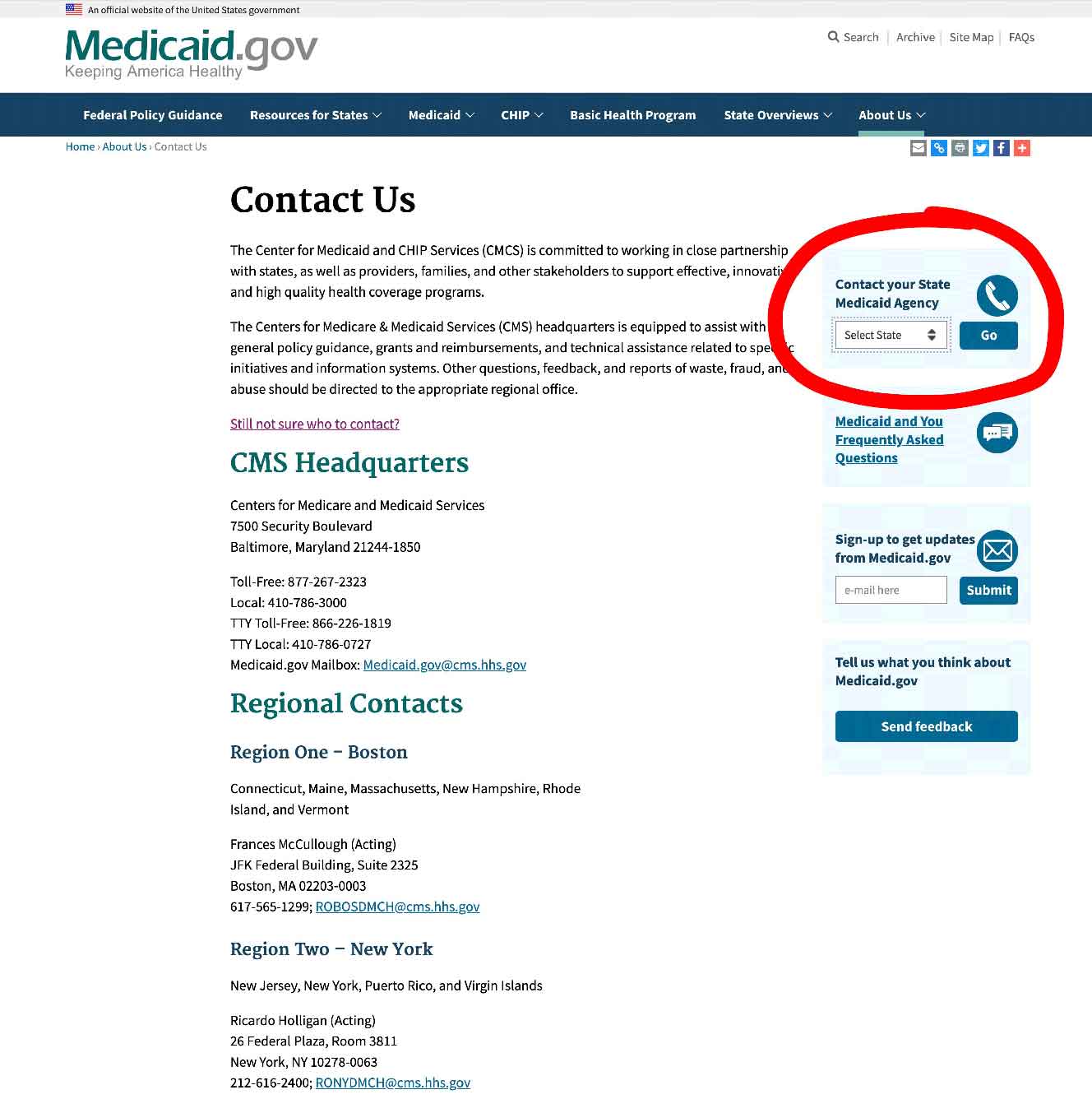
Step 2 –
Select your state and click on the button they have marked “GO” – it will take you to your State Medicaid Agency with all their contact info.
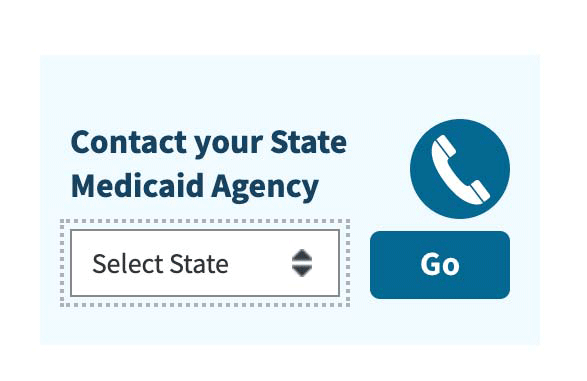
State Funding Assistance
Assistive Technology Projects
Thanks to the National Assistive Technology Grant, all states across the US have what is called a State Assistive Technology Project.
The idea behind the projects is to improve access to assistive devices in the home, primarily for the elderly and the disabled.
The terms “assistive technology device” and “durable medical equipment” can be considered synonymous for our purposes here.
State Assistive Technology Projects will typically have –
- an online exchange where you will be able to post assistive devices and medical equipment for sale, donation, or exchange – state residents only need to register to participate
- a main website which will coordinate the services, reply to questions and register individuals who need help
- reuse and recycling programs which are run by the state project, or by non-profits and community groups that partner with the projects, to provide free, or very cheap used equipment for the disabled, the elderly
- some projects have short and long term loan closets as part of their program
Go to your State Assistive Technology Project website to find out more.
To see what projects are in your state, click here
Step 1/
Pick your state on the map or the drop-down menu, and click on “Go to state”
– I chose Florida for this example
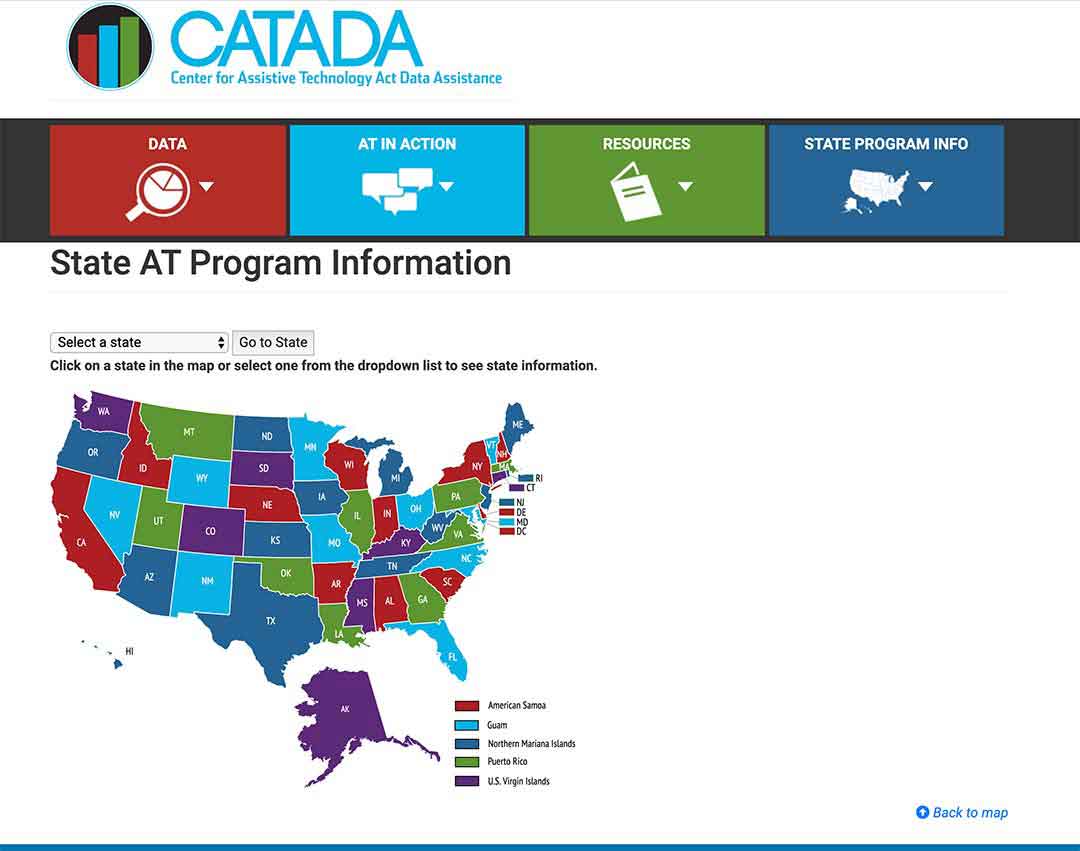
Step 2/
Click on the link “Program Title” – for my example, I outlined it in red.
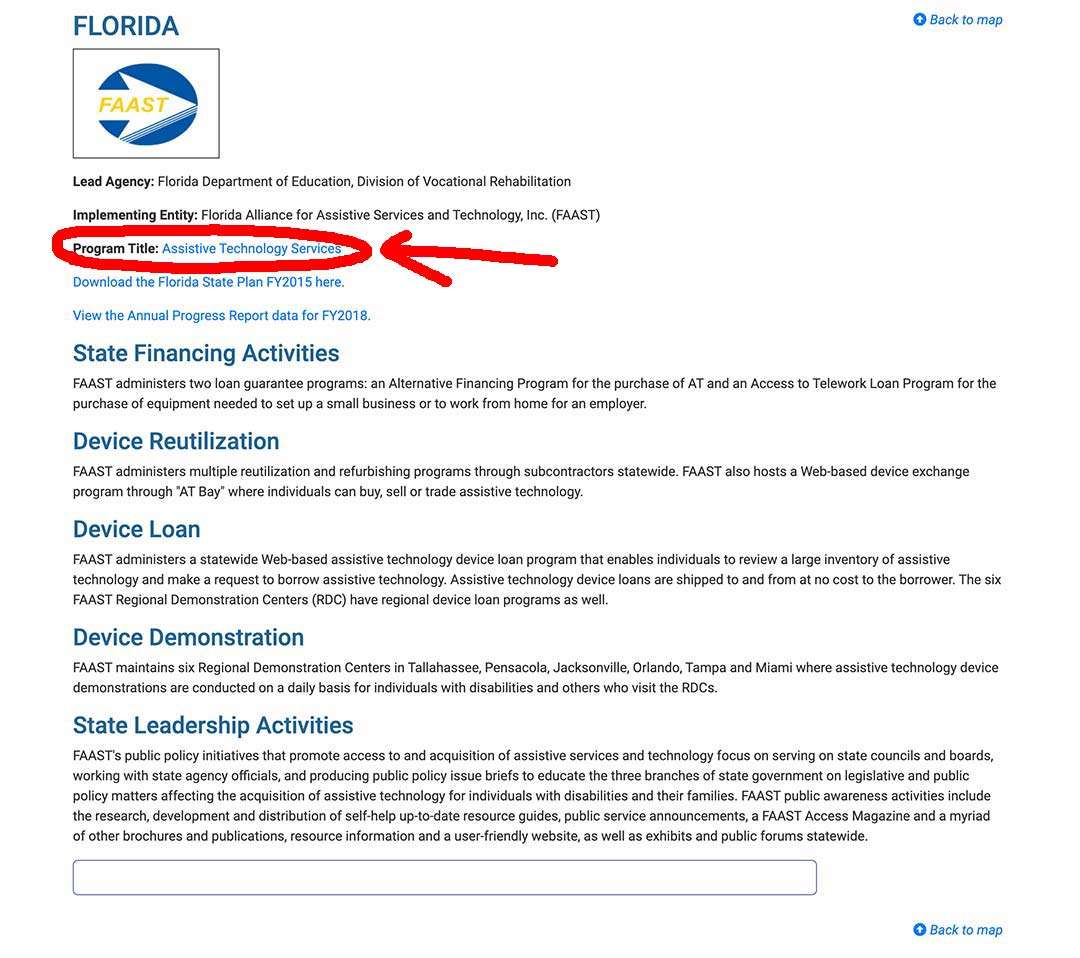
Step 3/
The AT Project state website will come up, and you can sign up, or use their contact info .
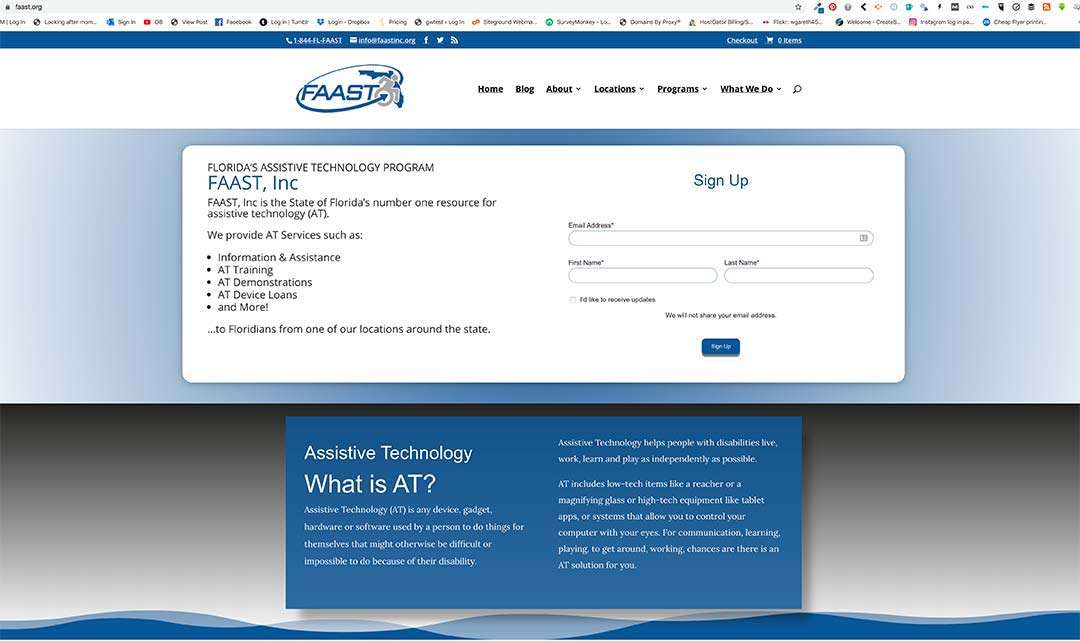
State Financial Assistance Programs
Non-Medicaid State Financial Assistance Programs exist in some states.
State Financial Assistance Programs will pay, with grants and loans, for assistive devices, safety equipment, durable medical equipment, as well as home modifications, so that the elderly and disabled may remain living independently in their own homes.
To find about State Financial Assistance Programs for the elderly and disabled, and if there is one in your state, check with your local Area Agency on Aging.
I’m Gareth, the author and owner of Looking After Mom and Dad.com
I have been a caregiver for over 10 yrs and share all my tips here.

